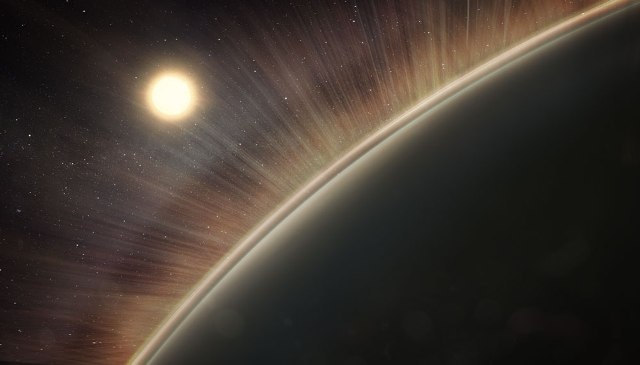Jun 21 2016
 (Credit: University College London)
(Credit: University College London)
A recent study conducted by a team of researchers belonging to NASA and UCL illustrated that a strong ‘electric wind’ across Venus is capable of removing the components of water from the planet’s upper atmosphere. This could have played a major part in the removal of the planet’s oceans.
It's amazing and shocking. We never dreamt an electric wind could be so powerful that it can suck oxygen right out of an atmosphere into space. This is something that definitely has to be on the checklist when we go looking for habitable planets around other stars.
Dr Glyn Collinson, Scientist, Goddard Space Flight Center, NASA
The study was published in the Geophysical Research Letters journal, and illustrates the discovery of the strong electric field in Venus. The strength of the electric field is so strong that it can speed up the heavy electrically charged parts of water, which is oxygen, - to speeds adequately rapid to escape the gravity of the planet.
Sunlight splits up the water into hydrogen ions and oxygen ions when water molecules evaporate into the upper atmosphere of Venus. The hydrogen ions are rapid and escape easily, and the heavier oxygen ions are taken away by the electric field.
We’ve been studying the electrons flowing away from Titan and Mars as well as from Venus, and the ions they drag away to space to be lost forever. We found that over 100 metric tons per year escapes from Venus by this mechanism – significant over billions of years. The new result here is that the electric field powering this escape is surprisingly strong at Venus compared to the other objects. This will help us understand how this universal process works.
Professor Andrew Coates, UCL MSSL
Of all the planets, Venus resembles Earth in terms of its gravity and size, and evidence implies that it had oceans long ago but boiled away to steam due to surface temperatures of approximately 860°F (460°C). As Venus with its thick atmosphere of approximately 100 times the pressure of Earth's, has 10,000 to 100,000 times less water than Earth, researchers suspect that something removed all the steam from its atmosphere.
Initially, scientists suspected that it was solar wind that was gradually eroding the ocean’s water and oxygen from the upper atmosphere of Venus. However, new findings indicate that a forceful electric wind was the reason.
The common belief is that just as there is a gravity field in all of the planets, there is also a weak electric field in the atmosphere of every planet. Gravity’s force tries to hold the planet’s atmosphere, its electric force assists in pushing the upper layers of the atmosphere into space.
Using the NASA-SwRI-UCL electron spectrometer, the team spotted the electric field present in Venus. The spectrometer is a part of a larger instrument known as ASPERA-4 aboard the ESA Venus Express. While observing the electrons escaping the upper atmosphere, they realized that the electrons were not escaping at their anticipated speeds as they were being pulled by the strong electric field present in Venus. The team was able to determine the field’s strength by measuring the change in speed. They found out that it was much stronger than anticipated - about five times stronger than at Earth.
We don't really know why it is so much stronger at Venus than Earth, but we think it might have something to do with Venus being closer to the sun, and the ultraviolet sunlight being twice as bright. It's a really challenging thing to measure and to date all we have are upper limits on how strong it might be here.
Dr Glyn Collinson, Scientist, Goddard Space Flight Center, NASA
A similar case of electric wind could be found in Mars as well. NASA's MAVEN mission is presently orbiting Mars to establish the reason behind the loss of a lot of its atmosphere and water.
Professor Coates added, “With ESA’s Mars Express, we have already caught this process in action at Mars, and MAVEN can now determine its relative importance. With NASA’s Cassini spacecraft we found that Titan loses 7 metric tonnes per day this way.”
Understanding the effect of electric winds in planets, astronomers will be able to determine the location and size of livable zones in the region of other stars in a better manner.
Even a weak electric wind could still play a role in water and atmospheric loss at any planet. It could act like a conveyor belt, moving ions higher in the ionosphere where other effects from the solar wind could carry them away.
Dr Alex Glocer, NASA Goddard